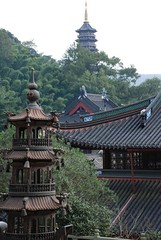It's been an even longer break between post one and two than it was between arriving in China and the first post. Techincal difficulties have been significant. Blogspot and Facebook are, indeed, blocked in in this country, and internet access is trickier than advertised. I figured out a workaround for the blocked sites by changing my passwords on on gmail and Yahoo, which change them on Blogspot and Flikr, which I set up for photo sharing. I then gave access to my accounts to Jyoshin. This way I can e-mail my blogs to her to post for me, and she can even link the to the photo site I set up. I can, thankfully, upload photos to Flikr, so that helps. As yet I see no way to access Facebook.
The last time I posted we had yet to see anything significant on the Zen tour, and since then we have seen a lot. I will, by necessity, have to be brief. The first temple we spent much time in is Ayuang Si, or the "Ashoka Temple" in Ningbo. Ashoka lived in India before Buddhism was a presence in China, so we were curious about this place. Apparantly the name comes from a dream a Chinese emporer had. It had to do with the merit of the Indian emperor Ashoka who established a reign of peace and harmony based on Buddhist principles, so that's a pretty good connection. The significant thing for us, however, is that this is the temple of the "Mushroom Monk," as we started calling him. This is the old Tenzo, or chief monastery cook, who made such a deep impression on young Dogen when he first arrived in China in the 1220s. This old monk gave Dogen solid, basic practice advice, and set his feet on the path in a solid way. Later Dogen visited him at this temple. We went to the kitchen to pay respects to this old teacher, even thought the temple has been rebuilt a number of times, and the kitchen is probably nowhere near the site of the one in Dogen's time. It's the thought that counts.
Next we went to Tientong Si, where Dogen practiced under Rujing. I was struck by how much it resembled Eiheiji. It is nestled in a mountain valley, close set on each side by wooded hills. It climbs up the valley in terraced settings for each main hall, so the temple climbs up the incline just as Eiheiji does. It has cloisters on either side that climb the hill with steep steps getting steeper at the top, above the main buildings. Way up at the top is a pavilion with a glorious view over tiled roofs toward the towering pagoda. That is a bit different than Eiheiji, which has a small pagoda, but similarly located. It is much funkier than temples in Japan, especially the gorgeous, immaculate Eiheiji, but the feel is wonderful.
Traveling with us is Eric and Samantha, from Wales, who practice in the Ch'an tradition. They figured out the schedule and how to join the monks for the evening service at 3pm. That turned out to include a special ceremony in honor of the ancestors of a group of lay people who offered incense and made prostrations. This added considerable length to the service, with an elaborate procession much like our serpentining. Everyone joined in, much as we do it at Dharma Rain. There were drums and cymbals, small bells and mokugyo. It was quite the treat for those who joined in, which was most of us. Others went to the top of the hill, where there is a hall of the arhats. On the other side of the wall is a national forest. The birders in the group went to do a little observing.
After the service we met an old monk who came out to greet us. I have his name and position here in front of me, which he wrote in a clear hand in elegant Chinese characters. When I get that translated, I'll let you know what it is. He was very interested in us foreign visiters, and enjoyed chatting with us through Eric, our guide and translater for the whole tour, and Mary, our Ningbo guide.
It's almost time for dinner at an amazing place here in the mountains near Huangbo's Dharma Seat. It's a restaurant called "Go Forward!" Andy calls it "The Great Leap Forward." It is, if you can imagine it, a retro/nostaglia theme spot based on the old Cultral Revolution days. Right now there is an old patriotic march in the heroic worker mode blaring from the PA. There are old posters and slogans on the wall. It's all a bit ironic, but not in the way we think of irony. They are not yet that jaded.
Well, time to go eat a turnip and old potato!

No comments:
Post a Comment